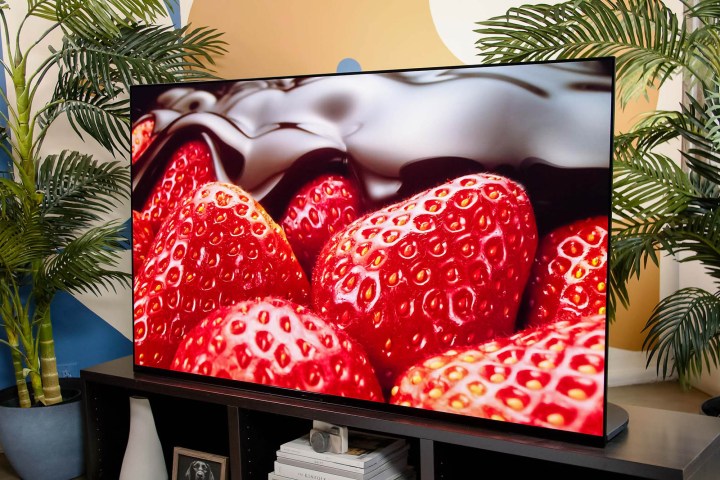- Next-level color purity
- High color brightness
- Wide color gamut
- Perfect black levels
- Great sound
- Expensive
The Sony A95K is the world’s first TV to be built using all-new QD-OLED display technology. Until now, the hype I’ve contributed around this TV has been based largely on brief glimpses of QD-OLED tech at CES 2022, details contained in a scientific white paper, and a handful of interviews I conducted on the topic. It’s been my prediction that QD-OLED technology alone is so next-level that it will change the TV game in 2022. Knowing that Sony has built a TV around this tech has given me enough confidence to predict the A95K will be one of the highest-performing TVs of the year, if not the hottest TV of 2022.
To find out if my prognostications were accurate, I flew to San Diego and paid Sony an exclusive visit at its U.S. headquarters. I spent many hours with the A95K, both at Sony’s HQ and at an offsite filming location. I’ve logged about 12 hours with the TV, gathering objective measurements and watching as much content as I could to give the TV a proper evaluation.
While I look forward to spending more time with the Sony A95K and will be pitting it against other high-performance TVs from competing brands in the weeks ahead, I was able to determine conclusively that the A95K — and QD-OLED tech in general — is everything I’d hoped it would be, and then some. Here’s my full review.
Sony A95K QD-OLED TV video review
The basics
The Sony A95K comes in 55- and 65-inch options (the XR-55A95K and XR-65A95K, respectively). Pricing and availability for the two models had not been announced as yet. But based on Sony rewards points information originally posted on Sony’s product pages for the A95K series, we expect the 55-inch model to be priced around $3,000 and the 65-inch model around $4,000. We will update this article once pricing has been made official.
The A95K is the first TV to use QD-OLED display technology, an evolution of conventional WOLED TV tech. QD-OLED holds the promise of offering brighter average picture levels while maintaining perfect black levels, resulting in higher-contrast images. Off-angle color saturation and contrast are also expected to be superior to other display technologies, including conventional OLED. Based on Samsung Display’s explanation of the technology, there is reason to believe that the already relatively low risk of burn-in associated with OLED TVs has been mitigated even more.
Out of the box

The A95K is Sony’s new flagship OLED TV, and, as expected, Sony has crafted a fresh look for the TV. The standout feature is the TV’s stand, which is reversible to provide two very different looks.
In most of the photos accompanying this review, the A95K is presented in what I’d consider a “traditional orientation,” with the base supporting the TV from the back. This approach places the bottom edge of the A95K flush against the surface of whatever it is placed on, mimicking a look we’ve seen from Sony’s flagship sets over the past couple of years. (It’s a look I happen to like, but be your own judge.)
The other configuration flips the base so it is at the front of the TV, thus allowing the back of the TV to fit flush against a wall behind it. This facilitates a wall-mounted look without the TV actually being wall-mounted. Also, as a representative at Sony pointed out — for those with little kids who think every screen’s a touchscreen, this orientation also places the screen a little further out of reach.
The base itself is a textured matte black — mitigating fingerprint woes — with the faintest bit of sparkle embedded deep into the finish. The base also happens to be quite heavy.

Of course, that heavy stand need not be removed from the box if wall-mounting is preferred. The A95K offers mounting-screw inserts in a standard VESA pattern for easy installation of a wall mount bracket.
Placed on the wall, the A95K QD-OLED offers a predictably slim profile. As with most OLED-based TVs, the top of the panel is slimmer than a smartphone, with a slight bump out at the lower two-thirds of the TV where the unit’s electronic guts are housed.
The TV ships with three plastic cover panels that snap into place to hide cables and give the back of the TV a clean look. A fourth plastic cover is provided to obscure a connection bay at the top-center of the back of the TV, where an included Sony Bravia Cam can be installed.
Features and design
The Sony A95K offers four HDMI ports, two of which support 4K/120Hz and variable refresh rate (VRR). To answer what I know has been a burning question for some time now: Variable refresh rate on the A95K (and, indeed, all Sony Bravia TVs) will work right out of the box (I’ll address VRR a bit more in the gaming section at the end of this review). It’s also worth pointing out that all 2022 Sony Bravia TVs have an ATSC 3.0 NextGen TV tuner.
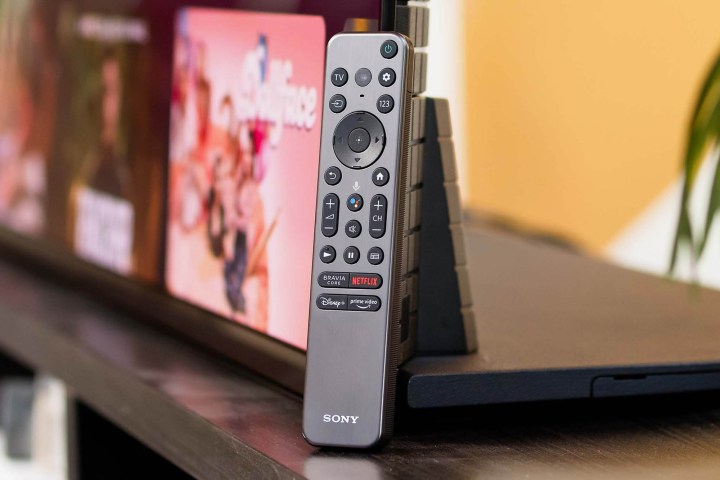
Sony has redesigned its remote control for its top-tier TVs, including the A95K. The new remote design is more compact, with fewer buttons. The A95K remote sports a deep bronze metallic finish on the front and a textured black plastic backing. The remote is backlit and features a small speaker on the back to work in coordination with Sony’s new “remote finder” function, which causes the remote to emit a chime when triggered by Google Assistant or by use of the power button on the back of the TV.
The front of the A95K is super clean and rather unremarkable — and that’s a good thing. Part of the reason the TV doesn’t call undue attention to itself is credited to the absence of an illuminated Sony logo. In fact, the only lights on the front of the TV are an amber light that can tell you if the TV’s microphone is on and listening, and a white LED that flashes when you press buttons on the remote. Both of these lights can be disabled in the TV’s system settings menu.
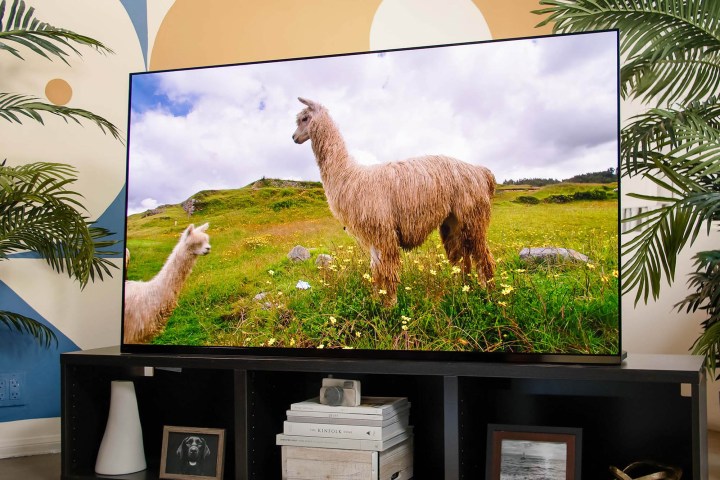
While it was difficult to capture on camera, it is worth mentioning that the TV’s screen is not jet black. Rather it appears very dark gray — similar to the appearance to the plasma TV screens of yore. I’m tempted to suggest this isn’t something most folks would notice, except I did notice it. Granted, however, I probably only noticed it because the A95K was sitting right next to a Sony A80K W-OLED TV, which does have a jet-black screen.
User experience

The A95K runs the Google TV platform and runs it exceptionally well. I was not at all surprised by this given Google TV’s performance on previous Sony televisions. The user experience is exactly what you’d expect if you’ve used a Google TV before. And if you haven’t … well, I think most folks will enjoy it.
Sony’s settings menus are easy to access and navigate.
Sony’s settings menus are easy to access and navigate. Each option comes with an explanation of what that setting does, enabling the user to make adjustments based on their personal preferences.
Recommended picture settings
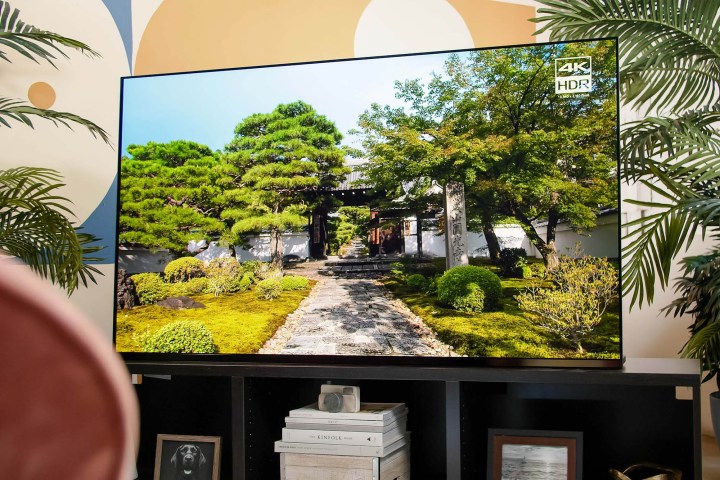
For my testing and subjective viewing evaluation, I used Sony’s “Custom” picture preset in both SDR and HDR modes. I used Dolby Vision Dark when watching Dolby Vision content on streaming services like Netflix, HBO Max, and Disney +.
Sony offers a “peak luminance” setting with options for Off, Low, Medium, and High. For most of my testing, this setting was left at Medium — the default selection for the custom picture preset. The only time I adjusted this setting was to test peak luminance values while measuring the TV’s output. In fact, the only adjustment I made to the out-of-box defaults for these presets was to disable motion smoothing. I left Sony’s “Cinemotion” setting intact, as I have found it does a good job at reducing judder without introducing “soap opera effect” when watching 20 frames-per-second (fps) film content.
As I will discuss below, I made only very minor adjustments to the A95K’s two-point white balance. I do not publish these numbers because TV performance varies enough from unit to unit that these values are not likely to be suitable for users to implement.
Sony A95K measurements
If you’re not big on measurements, please feel free to skip to the takeaway below. For those who do place stock in measurement data, please read carefully as these measurements alone fail to tell the larger picture-quality story.
To measure the A95K, I used Portrait Display’s Calman software, along with a SpectraCal C6 meter

Now, before I start tossing out numbers here, I need readers to understand that some of these numbers will not actually mean what one might think they should mean — and I’ll explain why.
This may come as something of a surprise to tech-heads, but the peak luminance measurement I got across several sizes of white test windows — from tiny to large — was right at 1,000 nits. That’s brighter than any prior OLED but short of what I expected given the TV looks so bright. I thought perhaps QD-OLED might break the 1,000-nit barrier.
The color on the Sony A95K is the most accurate I have ever seen.
I didn’t have any scientifically based reason to think that, though. I just expected this reading to be higher because my eyes had been telling me the A95K is the brightest OLED-based consumer TV I’ve seen. Turns out, my eyes weren’t deceiving me.
The A95K is an important study in why the peak white luminance measurement on which so many enthusiasts and reviewers are hung up — admittedly, that includes me — can be misleading. Because while that one measurement seems to indicate the TV isn’t that much brighter than other OLEDs I’ve tested, the real pay dirt of this TV is in the color brightness.
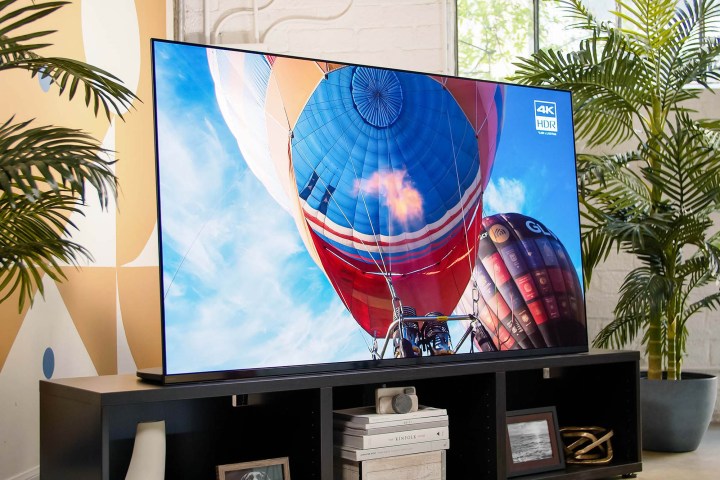
The A95K makes brighter blue, red, and green primary colors. But they aren’t just brighter, they are more pure as well. The real secret to this TV’s heightened performance is in the color purity. Especially the red. Oh, man, the red is just so much better. And not just better than other OLEDs, it’s better than most QLED TVs, too.
Certain hues of red just haven’t been produced on a TV … until now.
The TL;DR here is that the A95K QD-OLED has much higher perceptual brightness thanks to the fact that there is no color filter, making the colors purer and brighter. And when you apply those facts to real-world content instead of test patterns, you get a lusciously vivid, undeniably engaging picture from this TV.
Earlier, I mentioned that QD-OLED addresses a couple of WOLED annoyances. One of them is the slight green cast that whites and grays tend to have on WOLED TVs. It’s not something you really notice when you’re just watching a conventional OLED TV. But when you put one next to a QLED TV, you can clearly see the green cast. QD-OLED eliminates that. Whites and grays now are purer. And that translates well to color accuracy, too, which brings me to my next point.
The color on the Sony A95K is the most accurate I have ever seen. The margins of error in color performance are below the threshold of human detection. And with the simplest of two-point white balance adjustments, the color errors were the lowest I’ve ever seen in my 11-something years of reviewing TVs. Even more impressive: The A95K TV covers just over 90 percent of the BT.2020 color space, which is a nerdy stat I find extremely impressive.
The bottom line is the color is not just the most accurate I can recall seeing, it is also just undeniably beautiful. You will see colors on this TV that you have not seen on TV before — especially in the reds. Certain hues of red just haven’t been produced on a TV … until now. And you will see that when watching content.
Picture quality

The Sony A95K has the best overall picture quality I’ve seen on a consumer TV in terms of color, contrast, motion, detail, and depth. From a reviewer and TV enthusiast’s perspective, this TV ticks all the usual boxes, plus a few that haven’t been ticked before. For those who spend less of their valuable time obsessed with televisions, I’d say this: Sony’s A95K QD-OLED TV offers more of what always was awesome about OLED TVs while eliminating a couple of annoyances I’ve had with OLED in the past.
All the outstanding measurements I took early in my review process came to bear when I was finally able to sit back and just take in the A95K’s picture. To say I was dazzled might be a bit of an understatement — enthralled might be a more apt description for how I felt. But I think the big takeaway for me was that the A95K wasn’t just enjoyable to watch — it made me feel things.
At times, that feeling was actual hunger. Chef’s Table on Netflix is one of my go-to series for TV evaluations because food — when executed well — is art. And when properly displayed, the rich colors and textures contained in a well-composed dish can show a TV’s strengths and weaknesses. Not only did the A95K deliver all the complex intricacies of both the food and the context from whence it came, but it actually made me salivate.
I also frequently turn to Our Planet — also on Netflix — thanks to its demanding nature. It pairs slow-panning motion with vast, bright scenes, then seconds later pivots to a dark nigh-shot, where a TV’s backlight performance, black levels, and shadow detail can be instantly scrutinized. The Sony A95K presented Our Planet, along with just about every other nature documentary David Attenborough has ever hosted, with zest, detail, and highlights the likes of which I’ve not seen on previous displays I’ve reviewed.
Perhaps with deeper scrutiny, I may one day find some nit to pick, but in the time I was able to spend with the A95K, I was simply thrilled.
Since I’ve already used a couple of Netflix titles for examples, I’ll skip by how exhilarating it was to watch Lost In Space — arguably one of the most delightful examples of Dolby Vision HDR presentations you can stream on a TV — and home in on my experience watching Disney’s Encanto for the 132nd time. It was so engrossing thanks to its excellently executed palette of colors that I dismissed the inevitable earworm that is We Don’t Talk About Bruno as a hazard of doing business — and I was actually OK with that.
I watched sports — excellent motion clarity and color depth. I watched daytime TV — still hideous, but upscaled and digitally cleaned up as well as I’ve ever seen. I watched 4K Blu-ray material — as pristine as I’ve ever seen.
All told, everything I saw on the A95K was nothing short of a delight. I hunted for something to complain about — some little quirk that I could dwell on so this review didn’t seem like an out-of-balance, gratuitous gush.

I found nothing. Perhaps with deeper scrutiny, I may one day find some nit to pick, but in the time I was able to spend with the A95K, I was simply thrilled.
I know there will be many questions pursuant to this review. For example: Can it beat a super-bright mini-LED TV in a bright room? That’s a question to which I would have to ask: Beat it at what? I mean, if you have a sun-soaked room and only the sheer brightness of a TV is going to make images visible, then no, the QD-OLED can’t compete with a 2500-nit QLED TV. But if you have a moderately bright room, sun pouring in, but not shining right on the screen, I think most folks would be more than fine — they’d actually be thrilled with the A95K’s performance.
Yes. It really is that good.
Gaming
- 1. Sony A95K QD-OLED TV
I’m only casually mentioning gaming here, but I think this TV is going to be fantastic for the vast majority of those who enjoy video games at any level. While Sony doesn’t have the gamer-centric gaming hubs I’ve seen in LG and Samsung’s recent TVs, all the core requirements for a satisfying gaming experience are here: Low input lag, 4K/120Hz and VRR, Auto Game Mode. The A95K exceeds the requirements and capabilities of most gaming consoles and PCs. But I think what’s more important is its stunning picture. Sure, other TVs might give you a glimmer of an edge in a competitive first-person-shooter match (maybe … are you really that good?), but none of them will deliver the graphics with quite as much swagger as the A95K.
Sound quality

As expected, the Sony A95K is one of the better-sounding TVs you can buy. The TV uses its screen as its speaker system, and the result is a convincing soundstage that is balanced, uncontested, slightly punchy, and remarkably effective at delivering stereo effects. With that said, I think the TV demands at least a quality soundbar to bring the sound quality up to par with the picture quality.
Our take
The Sony A95K QD-OLED TV is a significant advancement of OLED TV technology. If prior OLED TV models showed iterative improvements year over year, the A95K represents a significant step up. It is literally next-level. And oh, man, it is soooo good.
Is there a better alternative
No, not at this time. If and when Samsung releases its own version of a QD-OLED TV (which is very likely to happen in the second half of 2022), we will reevaluate. From a cost-saving perspective, the Sony A80K and LG C2 OLED TVs would make very compelling alternatives, bringing to the table 90 percent of the picture quality at a fraction of the price, with more size options available.
How long will it last?
QD-OLED technology is built to be longer-lasting than W-OLED technology, with a lower risk of burn-in. I expect the A95K will be a top-tier performer for many years of its life, and to generally last well into the future.
Warranty
Sony offers a one-year warranty on the XR-55A95K and XR-65A95K TVs. More warranty information can be found here.
Should you buy it?
Yes. The Sony A95K is one of the best-performing TVs that’s ever been made and may wind up being the best TV of 2022.







